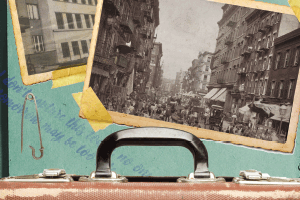A Dream and a Suitcase
| September 21, 2015
“My savta was special," I kept hearing. “"She was larger than life… everyone always wanted to be near Savta."”
Well, isn’t everyone’s savta special? But when I heard that this particular savta traveled to Poland from the US to become the only American in Sarah Schenirer’s seminary, I realized she was no garden-variety savta.
No, “Savta” was Rebbetzin Chava Pincus, nee Weinberg — the sister of Rabbis Yaakov and Noah Weinberg ztz”l, and the mother of Rav Shimshon Pincus ztz”l. Spunky and idealistic throughout her life, she instigated the Bais Yaakov movement in America and served as a teacher and mechaneches for six decades.
And while her children and grandchildren treasured a close relationship with the grandmother they describe as simultaneously soft and strong, a closer read of her personal memoir sheds new light on her prodigious intelligence and an outlook steeped in Torah, even as it provides a rich window into Jewish life on both sides of the Atlantic over most of the 20th century.
Mountaintop Haven
Rebbetzin Pincus came from illustrious stock; her father’s brother was the Slonimer Rebbe in Teveria, while her mother came from the prestigious Lorberbaum family. “My mother was the fifth generation of Lorberbaums, the ninth generation after the Chacham Tzvi and the seventh after the Chavas Daas, Rav Yaakov of Lissa,” she writes. Her grandfather would spend the entire week learning in the shul of the Ari Hakadosh, coming home only for Shabbos; his wife would send food with one of Chava’s younger aunts. She recalls how as a baby she observed him one night:
I remember being in a vigale, a small wooden cradle. I woke up in the middle of the night, and my grandfather was rocking me with his foot, while learning by candlelight. I see clearly his radiant face, and can almost hear the Gemara melody as he learned and rocked me… The people in Tzfas were proud of him, and many miracles were related about him.
Her description of Tzfas in those times depicts a saintly, picturesque mountain hamlet:
The whitewashed houses of the little city shimmered in the sun, and it looked like a city of crystal, [an image] in perfect harmony with its purity and holiness. In our yard, there was a tree with beautiful pink and purple flowers, which would close at night like morning glories and open after sunrise. The yard was paved with quaint balatos, stones of different sizes painted with a light-blue whitewashed line around each stone.
I used to go with my aunt to be present at the milking of a herd of goats. It was an experience to be way up above the city on the high crags, the powerful mountain winds blowing through our hair and almost knocking me over, hearing the bleating of the goats and bringing the milk home for everyone to drink.
Dangerous Waters
Chava’s father, who refused to accept a rabbinic position because he didn’t believe in making money from Torah, built a mill on the waters of the Jordan to grind wheat for the farmers of the Galil. (He also worked as a mohel.) When he wasn’t busy, he’d sit and learn. Little fish swam in the waters, and the local Arab women would come to catch them.
There were constant warnings that they shouldn’t come close to the wheels of the mill. But one day an Arab woman disregarded the warnings, and her hair was caught in the wheels of the mill and she was killed. The Turks, who ruled Palestine, arrested my father and put him in a dungeon.
An aunt managed to secure his freedom, but he had to flee to the US. Chava’s mother was left alone with two babies, during the terrible wartime famine and hardship. She became the breadwinner; her sister had a knitting machine, and would produce stockings and scarves that she’d take to Beirut and sell, exchanging them for a precious sack of flour. Chava remembers food being so scarce that her mother and grandmother weighed every piece of bread on a scale before distributing them to each family member.
In 1917, the Balfour Declaration announced the British government’s official support for a Jewish homeland in Palestine. When Lord and Lady Balfour came to visit Tzfas, she writes, the excitement was “indescribable.” Although just a little girl, she was drafted into the festivities:
Dressed in a white silk dress with a blue sash, I was chosen to welcome these illustrious visitors. I was to present them with a bouquet of flowers and give them a brachah as they entered the city. But the streets were so crowded, and there was so much noise and movement, that I couldn’t give my brachah! I was simply picked up and put into their royal coach, and barely managed to hand them the flowers.
Oops! We could not locate your form.
